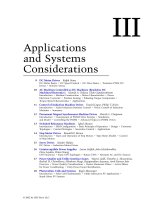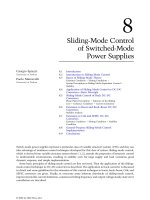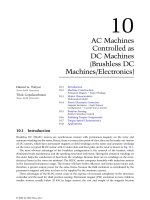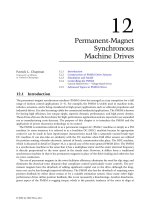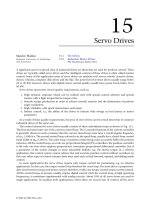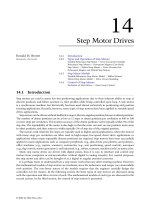Tài liệu Power Electronic Handbook P21 docx
Bạn đang xem bản rút gọn của tài liệu. Xem và tải ngay bản đầy đủ của tài liệu tại đây (586.63 KB, 13 trang )
© 2002 by CRC Press LLC
21
More-Electric Vehicles
21.1 Aircraft
Conventional Electrical Loads • Power Generation
Systems • Aircraft Electrical Distribution
Systems • Advanced Electrical Loads • Advanced Electrical
Distribution System Architectures • Conclusions
21.2 Terrestrial Vehicles
Electrical Power Systems of Conventional Cars • Advanced
Electrical Loads • Increasing the System Voltage •
Advanced Distribution Systems • Electrical Power Systems
of Electric and Hybrid Electric Vehicles • Automotive
Electric Motor Drives • Conclusions
21.1 Aircraft
Ali Emadi and Mehrdad Ehsani
Mechanical, electrical, and centralized hydraulic and pneumatic systems are conventional power transfer
systems in an aircraft. The More-Electric Aircraft (MEA) concept emphasizes utilizing electrical systems
to replace more aircraft conventional power transfer systems and to facilitate new introduced electrical
loads. Improving reliability, maintainability, supportability, survivability, performance, safety, emissions,
and operating costs are the main motivations behind the MEA concept.
Conventional Electrical Loads
The power needed for the subsystems in an aircraft is currently derived from mechanical, electrical,
hydraulic, and pneumatic sources or a combination of them [1–3]. Generally, hydraulic power transfer
systems are used for most of the actuators. On the other hand, pneumatic power transfer systems are
mainly employed for air-conditioning, pressurization, and ice protection systems.
Electrical and electronic systems are usually used for avionics and utility functions, such as air data
instruments, communications, landing gear, lighting, navigation, and comfort of the passengers. Other
conventional subsystems that are driven by the electrical sources include energy storage, engine starting,
ignition, anti-skid control, and deicing and anti-icing systems [3].
Power Generation Systems
The wound-field synchronous machine has traditionally been used to generate AC electrical power with
constant frequency of 400 Hz. This machine/drive system is known as a constant-speed drive (CSD)
system [3–5]. Figure 21.1 shows a typical constant-speed drive system. In Fig. 21.1, synchronous gener-
ators supply AC constant-frequency voltage to the AC loads in the aircraft. Then, AC-DC rectifiers are
used to convert the AC voltage with fixed frequency at the main AC bus to multilevel DC voltages at the
Ali Emadi
Illinois Institute of Technology
Mehrdad Ehsani
Texas A
&
M University
© 2002 by CRC Press LLC
secondary buses, which supply electrical power to the DC loads. Excitation voltage of the synchronous
generator and firing angles of the bridge rectifiers are controlled via the control system of the CSD system.
Recent advances in the areas of power electronics, control electronics, electric motor drives, and electric
machines have introduced a new technology of variable-speed constant-frequency (VSCF) systems. The
main advantage of VSCF is that it provides better starter/generator systems. Other advantages are higher
reliability, lower recurring costs, and shorter mission cycle times [5]. Figure 21.2 shows the block diagram
of a typical VSCF starter/generator system. In the generating mode, an aircraft engine, which has variable
speed, provides mechanical input power to the electric generator. Then, the electric generator supplies
variable-frequency AC power to the bidirectional power converter, which provides AC constant-frequency
voltage to the main bus. In the motoring mode, the constant-frequency AC system via the bidirectional
power converter provides input electric power to the electric machine, which is a starter to the aircraft
engine. Synchronous, induction, and switched reluctance machines are three candidates for VSCF
starter/generator systems [3–6].
The bidirectional power electronic converter of the VSCF system is a multilevel converter, as depicted
in Fig. 21.3. The input voltage is variable AC whose amplitude is not regulated. Moreover, the frequency
is not constant. At the input stage of the bidirectional converter, there is an uncontrolled rectifier con-
verting the variable AC to an unregulated DC voltage. Then, a DC voltage regulator is used to provide
power for the regulated high-voltage 270-V DC system. A DC-DC converter and a DC-AC inverter
connected to this system provide power for the low-voltage 28-V DC and 115/200-V, 400-Hz, three-phase
AC loads, respectively. Batteries are also connected to the system via the battery charge/discharge unit.
Aircraft Electrical Distribution Systems
Because of the expansion of electrical loads and the replacement of conventional aircraft systems with
the electrical counterparts, aircraft power systems are becoming more electric. As a result, in advanced
aircraft, electrical distribution systems with larger capacity and more complex configuration are necessary.
FIGURE 21.1
Typical CSD system.
FIGURE 21.2
Typical VSCF starter/generator system.
Primemover
Synchronous
Generator
Bridge
Rectifiers
DC Loads
Control
System
AC Loads
Excitation
Voltage
V
AC
V
DC
Control
Signals
© 2002 by CRC Press LLC
Systems with constant-frequency (CF) and VSCF have 115-V AC, 400-Hz, three-phase electrical systems.
They may also have a 270-V DC or higher primary power bus. The electrical system of an aircraft may
have wild frequency with a variable-frequency VF generator of 115 V AC, three-phase power [7].
In the MEA electrical power systems, a number of different types of loads are used, which require
power supplies different from the standard supplies provided by the main generator. Therefore, the future
aircraft electrical power systems will employ multivoltage-level hybrid DC and AC systems. For example,
in an advanced aircraft power system having a 270-V DC primary power supply, certain instruments
and electronic equipment are employed that require 28-V DC and 115-V AC supplies for their operation.
In fact, DC cannot be entirely eliminated even in aircraft that is primarily AC in concept. Furthermore,
even within the items of consumer equipment themselves, certain sections of their circuits require
different types of power supply and/or different levels of the same kind of the supply. It therefore becomes
necessary to employ not only equipment converting electrical power from one form to another, but also
equipment converting one form of supply to a higher or lower value. As a result, in a modern aircraft,
different kinds of power electronic converters such as AC-DC rectifiers, DC-AC inverters, and DC-DC
choppers are required. In addition, in the VSCF systems, solid-state bidirectional converters are used to
condition VF power into a fixed frequency and voltage. Moreover, bidirectional DC-DC converters are
used in the battery charge/discharge units.
As the AC-DC converters, conventional transformer rectifier units (TRU) are used. Each unit consists
of a 12-pulse transformer and a controlled or uncontrolled rectifier. Power diodes and thyristors are used
in uncontrolled and controlled rectifiers, respectively. If a constant voltage is needed, controlled rectifiers
are used to regulate output voltage. And, if it is not necessary to regulate the output voltage or if there
is a voltage regulator at the output side of TRU, uncontrolled rectifiers are used. However, in an advanced
MEA, recent advances in the area of power electronics, such as resonant and soft switching techniques,
can be used to increase the power density and improve the performance of all the power conditioning
systems [8].
Advanced Electrical Loads
Performance improvements in electric actuation systems and electric motor drives are providing the
impetus for the MEA concept. In fact, there is a trend toward replacement of more engine-driven
mechanical, hydraulic, and pneumatic loads with electrical loads as a result of performance and reliability
issues.
In an advanced aircraft, electromechanical actuators are used instead of the conventional hydraulic
actuators. The expansion of this concept to braking systems results in electrically actuated braking systems
[9]. Improved safety, reliability, and maintainability are the benefits that accrue through the removal of
the hydraulic fluid. In addition, the efficiency is improved through better control of braking torque [9].
FIGURE 21.3
Multilevel conversion of the unregulated AC voltage to regulated DC and AC voltages.
© 2002 by CRC Press LLC
Furthermore, conventional aeroengine actuators use fluid power in the form of pneumatic, hydraulic,
or fueldraulics to provide the motive effort. There is also a trend toward replacing these traditional
hydraulic/pneumatic/fueldraulic engine actuation systems with electromechanical actuators. The main
advantages are easier interfacing, reduced maintenance costs, lighter systems, and improved reliability.
The electric motor type selected is a three-phase brushless DC motor [10].
Some of the other loads considered are electromechanical and electrohydraulic flight control actuators,
270-V DC switched reluctance starter/generators, electric anti-icing systems, environmental systems,
electromechanical valve controllers, air-conditioning systems, utility actuators, weapon systems, and
different electric motor drives for pumps and other applications. In fact, electrical subsystems may require
a lower engine power with higher efficiency. Also, they can be used only when needed. Therefore, MEA
can have better fuel economy and performance. Figure 21.4 shows the main electrical power subsystems
in the MEA power systems.
Advanced Electrical Distribution System Architectures
A conventional distribution network is a point-to-point topology in which all the electrical wires are
distributed from the main bus to different loads through relays and switches. This kind of distribution
network leads to expensive, complicated, and heavy wiring circuits. However, in an advanced aircraft,
loads are controlled by intelligent remote modules. Therefore, the number and length of wires in the
harness are reduced. Furthermore, by interconnection between remote modules via communication/con-
trol buses, it is possible to have a power management system (PMS). The primary function of the PMS
is time-phasing of the duty cycle of loads to reduce the peak power demand [11]. Other functions of the
PMS are battery management and charging strategy in a multiple-battery system, load management,
management of the starter/generator system including the regulator, and provision and control of a high-
integrity supply system. In addition, power management strategy can help optimize the size of the
generators and batteries [11].
Figure 21.5 shows an advanced aircraft power system architecture in which there are several power
electronic converters. The distribution control network of Fig. 21.5 simplifies vehicle physical design and
assembly and offers additional benefits from the integration with intelligent power management control.
Other advantages of this MEA technology are reduced design complexity, fewer flight test hours, reduced
ground support equipment, and easier aircraft modification [7].
To power important systems in the case of an emergency, permanent magnet (PM) generators are
used to generate 28-V DC voltage. Furthermore, the main distribution system can also be changed from
DC to AC. The main advantage of AC distribution systems is easy conversion to different voltage levels
by transformers. Also, AC machines are easy to use.
FIGURE 21.4
MEA electrical power subsystems.
© 2002 by CRC Press LLC
Specifications of the DC-DC converters and DC-AC inverters for MEA applications are given in Ref. 12.
Two power electronic converters, which are highly compact with input nominal voltage of 270 V DC,
are presented in Ref. 12. The DC-DC converter provides 5.6 kW at 29
±
0.5 V DC with an efficiency of
90%. The DC-AC inverter provides 8 kVA of three-phase power at (115
±
1.5)/200 V AC and 400 Hz
with an efficiency of 87%. Both of these converters have high-frequency (120-kHz) resonant circuits.
The reason for using the resonant circuits is that the power electronic devices are switched at zero current.
This reduces the switching power losses and, in turn, increases the efficiency and switching frequency to
120 kHz [12].
Conclusions
To improve aircraft reliability, maintainability, emissions, and performance, the MEA concept emphasizes
the utilization of electrical systems instead of the conventional mechanical, hydraulic, and pneumatic
power transfer systems. The MEA concept facilitates high-power electric loads and requires power
electronics in a solid-state rich electric environment. In fact, advanced aircraft and aerospace power
systems are multiconverter power electronics–based systems. In these systems, different converters, such
as AC-DC rectifiers, DC-DC choppers, and DC-AC inverters, are used to provide power at different
voltage levels in both DC and AC forms. The AC system may be constant frequency, multifrequency, or
wild frequency. In addition, advanced aircraft power systems employ separate buses for power and control
as well as an intelligent power management center.
References
1. R. E. Quigley, More electric aircraft, in
Proc. 1993 IEEE Applied Power Electronics Conf.,
San Diego,
March 1993, 609–911.
2. J. A. Weimer, Electrical power technology for the more electric aircraft, in
Proc. IEEE 12th Digital
Avionics Systems Conf.,
Fort Worth, Oct. 1993, 445–450.
FIGURE 21.5
The concept of an advanced aircraft power system architecture of the future.

